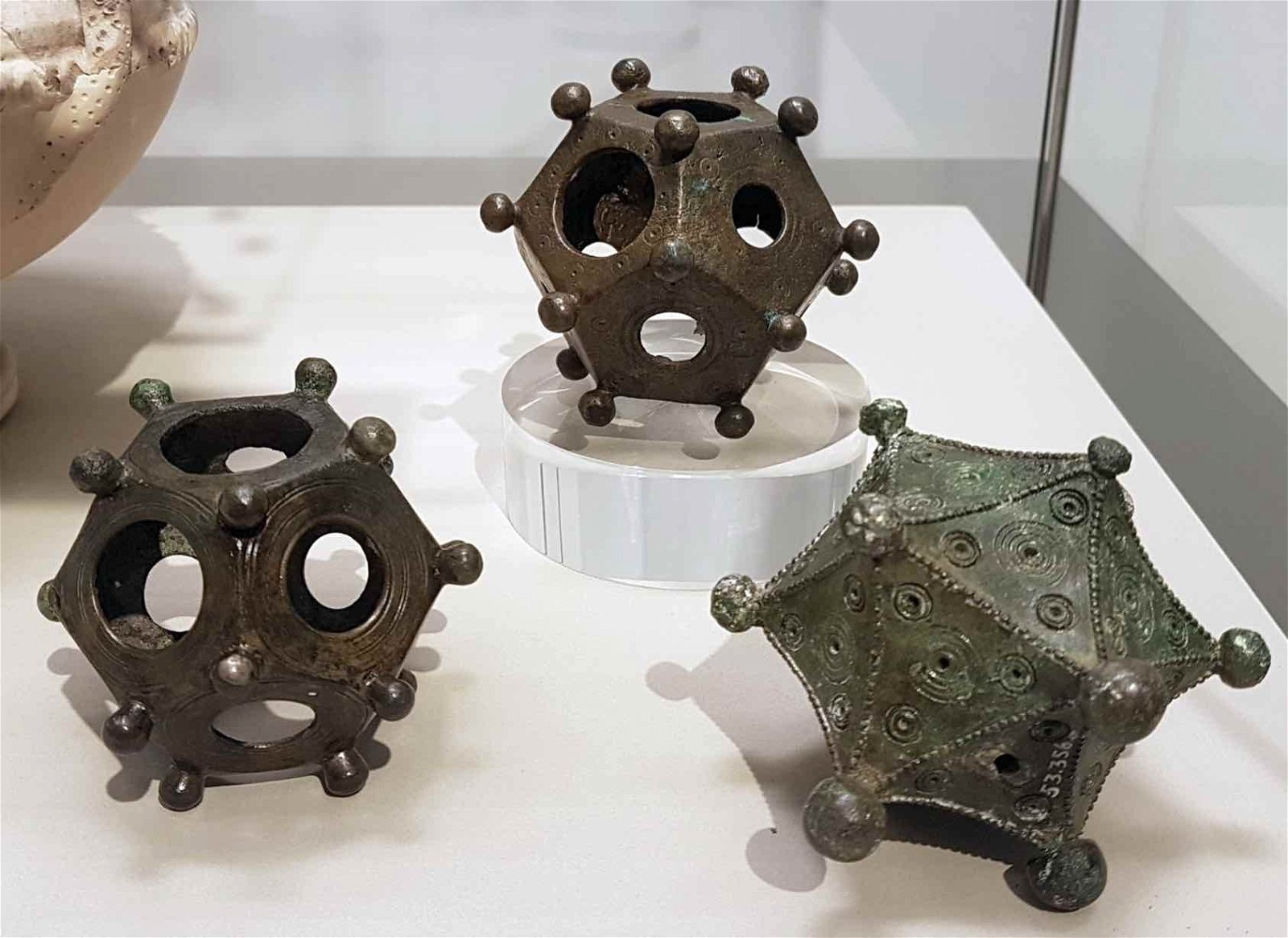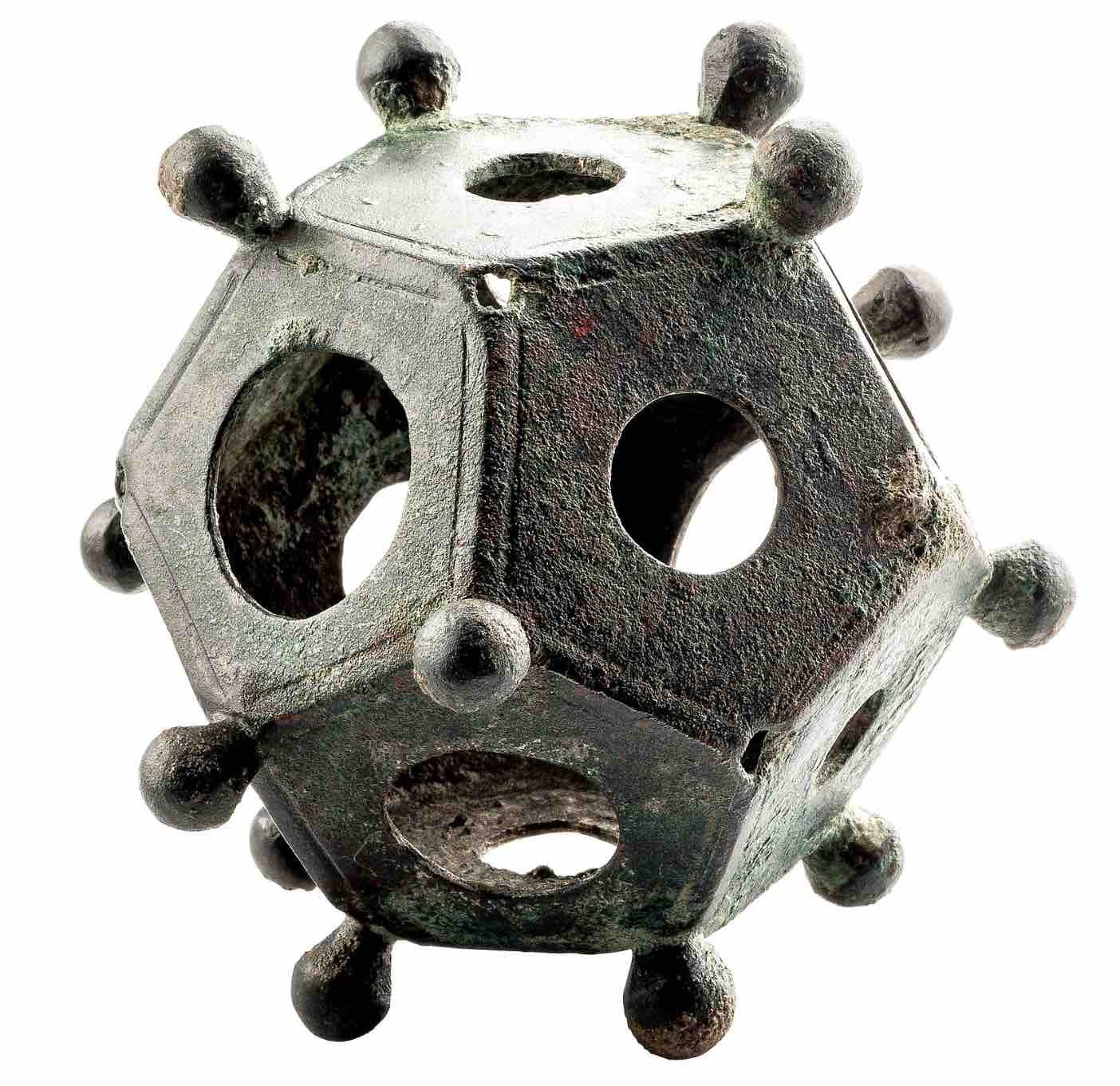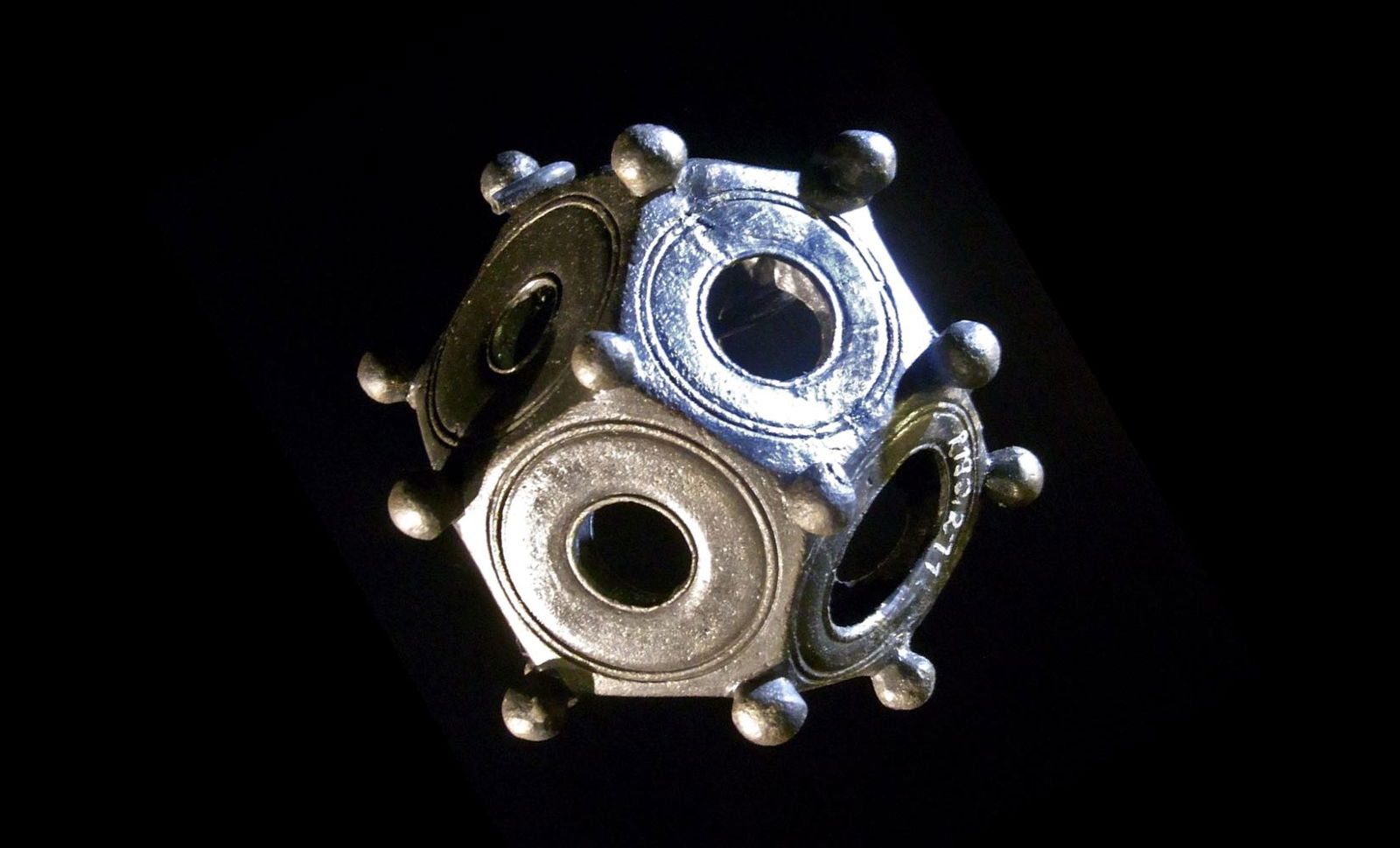They represent an archaeological curiosity that has baffled experts since their first discovery in the 18th century, and with no historical accounts or imagery that offer clues about their use, archaeologists remain unclear about what their purpose might have been.
Known as Roman dodecahedrons, these baffling objects are on average about the diameter of a soda can, although their sizes vary. Each of the hollow objects, made mostly from bronze, but occasionally also stone, possesses twelve flat pentagonal faces with a single hole of varying size in their center, and small knobs at each corner of the junctions of the faces. Currently, around 116 of the objects are known to exist, discovered at archaeological sites throughout Europe that place their age between the 2nd and 4th centuries AD.
No lettering or numbers appear on any of the Roman dodecahedrons that have currently been discovered, although similar objects that include 20-sided icosahedrons of comparable design have also been found. Like many curiosities of the ancient past, their distinctive appearance is strongly suggestive that they were created as devices designed with a specific purpose. Why else would one go to all the trouble of crafting them otherwise?


Although there is still no explanation that researchers agree on in terms of what the objects may have been intended for, several theories have propelled the debate now for decades, and archaeologists may be closing in on discoveries that could provide much-needed context for answering the remaining questions about these ancient Gallo-Roman curiosities.
History
The earliest known discovery of a Roman dodecahedron is believed to have occurred in 1739 near Aston, Hertfordshire, England. According to an 1849 catalog entry in the miscellaneous collections of the Society of Antiquaries of London, a bronze Roman dodecahedron “found with copper coins at Aston, in Hertfordshire, in a field called Hagdale, was exhibited to the Society by Mr. North [on] June 28, 1739.”
The 1849 entry also discusses the discovery of a similar dodecahedral object nearly three decades later, unearthed from a depth of close to 8 feet on the grounds of St. Peter’s Church at Carmarthen that occurred in May 1768. Described as a “singular object of bronze, in form of a hollow dodecahedron,” the artifact featured “a ball attached to each angle” and a circular opening on “each of its pentagonal sides … the diameters of these perforations increasing gradually from six-tenths to about 1 ½ inch. Each side measures, in diameter, 2 1/5 inches.”


“Several pieces of copper, curiously laid in flag-bricks, were found at the same time, but they crumbled to dust,” the entry states, although it is unclear whether these bricks had any specific relationship to the dodecahedron. Finally, the 1849 catalog entry mentions the discovery of a third dodecahedron “but of smaller size and without balls at the angles, found near Fishguard,” which was delivered to the Society of Antiquaries by the Rev. Edward Harries of Llandysilio, Pembrokeshire, on March 12, 1846.
Over the ensuing centuries, dozens more of the objects have been found in England, France, Germany, Belgium, Austria, the Netherlands, and surrounding countries. Curiously, the objects have remained absent amidst archaeological discoveries made in Italy, where one might otherwise presume a concentration of objects of Roman provenance would be located, further adding to the mystery of their purpose.
Theories
Given that there is virtually nothing to provide historical context for what these objects may have been designed and used for, a range of theories have emerged over the years that could offer potential solutions to the mystery of the dodecahedrons.
One of the earliest proposed theories among scholars in the 19th century had been that the objects may have been implements of warfare, perhaps serving as a mace head, a component of a net or bolas-type throwing weapon, or even a projectile. However, the hollow design of the dodecahedrons would seem to impose obvious limitations on their effectiveness if used for such purposes.
More recent theories about the Roman dodecahedra involve their possible use as measurement gauges or as a surveying instrument, while other theories hold that they may have had an artistic or decorative purpose. Other theories put forward over the decades have argued that the dodecahedrons may have served as everything from candlestick holders to gaming implements, devices used for determining sowing dates, calibration tools for water pipes, or possibly army standard bases used by Roman soldiers.
According to Amelia Carolina Sparavigna, a researcher with the Department of Applied Science and Technology at the Polytechnic University of Turin, Italy, one novel possibility is that the Roman dodecahedrons served as dioptrons (i.e., rangefinders). Drawing from sources based entirely online, Sparavigna concluded in a 2o12 paper that features common among all the known Roman dodecahedrons point to their use as optical instruments for the measurement of angles and estimating distances.


Another novel theory involves the use of Roman dodecahedrons as astronomical devices. Experiments conducted by researcher G.M.C. Wagemans led him to posit that the devices could be used to measure the angle of sunlight, which may have been used by ancient farmers to determine specific dates that coincided with ideal sowing dates for certain annual crops.
“The sowing date of winter grain is important for the achievement of optimal produce,” Wagemans writes in an article outlining the hypothesis at his website. “Therefore I anticipate that the dodecahedron would only be used in autumn time.”
Several years ago, another novel theory was put forward by Martin Hallett on his YouTube channel, where he demonstrated how a scale replica of a Roman dodecahedron created with a 3D printer could be used as a knitting device to aid in making gloves.
“People must have been using them for something useful for there to have been so many made,” Hallet wrote. “I wanted to see what they might have been used for so I got one made with a 3D printer and, well watch to see what they can do.” You can see the potential use for the objects that Hallet discovered in the video below:
However, not everyone is convinced that the objects were designed to be used as tools for measurement or other technical purposes.
“They are not of a standard size, so will not be measuring devices,” wrote members of the Norton Disney History and Archaeology Group on their website last December, following the discovery of one of the dodecahedrons during excavations in June 2023.
“They don’t show signs of wear, so they are not a tool. Nor are they devices for knitting,” the group’s members wrote, adding that “A huge amount of time, energy and skill was taken to create our dodecahedron, so it was not used for mundane purposes, especially when alternative materials are available that would achieve the same purpose.”
So if not an ancient tool for measurement, astronomy, or knitting, what do archaeologists and other experts like those with the Norton Disney History and Archaeology Group think these enigmatic little objects might have been used for?
Clues in Context: Unraveling the Mystery of the Roman Dodecahedrons
While there are no historical records or artistic depictions that offer an indisputable solution to the Roman dodecahedron mystery, some clues do arise from the location and conditions in which the artifacts have been unearthed during archaeological excavations.
One possibility—a theory that is well-worn in archaeological circles when it involves items of unknown purpose or function—holds that the dodecahedrons may have had religious significance or were perhaps even occult implements used for fortunetelling. One clue that could indeed point to their association with religious beliefs of the period involves the prevalence of the objects at sites associated with the Gallo-Roman Empire, where a synthesis of Roman and Hellenistic religions was in practice that incorporated the traditional religion of the Gauls, which featured influences derived from Eastern mystery religious cults.
“Roman society was full of superstition, something experienced on a daily basis. A potential link with local religious practice is our current working theory,” the Norton Disney History and Archaeology Group wrote last year on its website, although noting that additional investigation will be required to confirm the idea.
Returning to utilitarian purposes, some point to the cost of bronze between the 2nd and 4th century AD, as well as the proficiency that would have been required to cast objects as intricate as the Roman dodecahedrons, as possible clues indicating they were related in some way to the metalsmithing trade.
Additionally, some have proposed that the dodecahedrons–whatever purpose they might have otherwise held–could also have been seen as items of value; a theory that is potentially still in line with ideas involving their religious use and costs associated with their creation. A prime indicator of their potential value is their prevalence among cashes of coins, as observed by researcher Bernhard A. Greiner in his 1996 paper, “Roman dodecahedrons: studies of typology, manufacture, distribution, and function.” While this may be suggestive of value associated with the Roman dodecahedrons, an alternative that some researchers have argued is that this could simply mean the objects were related to coins in some other way that remains undetermined, and were not viewed as valuables themselves.
In the absence of any definitive answers, archaeologists like those with the Norton Disney History and Archaeology Group say they plan to resume excavations later this year, with hopes of finding additional clues that may help to shed light on the curious Roman dodecahedrons like the one they unearthed last June.
So where does all of this leave us regarding the mystery of the Roman dodecahedrons?
Simply put, none of the existing theories or contextual clues researchers have put forward can conclusively solve the mystery, and therefore much work remains to be done before a final resolution can be agreed on. However, the ongoing fascination these objects continue to generate, paired with the natural human drive to seek answers about our past, could indeed mean that a resolution to this longstanding mystery–one now several centuries in the making–could finally be on the horizon.
Micah Hanks is the Editor-in-Chief and Co-Founder of The Debrief. He can be reached by email at micah@thedebrief.org. Follow his work at micahhanks.com and on X: @MicahHanks.

